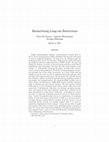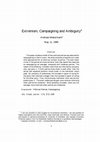Papers by Andreas Westermark
American Economic Journal: Macroeconomics, Oct 1, 2022
We show that business cycles reduce welfare through a decrease in the average level of employment... more We show that business cycles reduce welfare through a decrease in the average level of employment in a labor market search model with learning on-the-job and skill loss during unemployment. A negative correlation between unemployment and vacancies implies, via the concavity of the matching function, that business cycles reduce the average number of new jobs and employment. Learning on-the-job implies that the decrease in employment reduces aggregate human capital. This, in turn, reduces the incentives to post vacancies, further decreasing employment and human capital. We quantify this mechanism and …nd large output and welfare costs of business cycles.
Review of Economic Dynamics, Jul 1, 2021
Using a unique dataset of all Swedish housing transactions over the 2009-2017 period, we find tha... more Using a unique dataset of all Swedish housing transactions over the 2009-2017 period, we find that an increase in manufacturing's share of employment is positively associated with house price growth volatility and negatively associated with risk-adjusted housing returns. Both effects appear to be related to manufacturing's impact on firm concentration and employment volatility. Moreover, as we demonstrate in an application, our results have implications for portfolio choice. They also suggest that the manufacturing decline since 1970 could account for a 32% reduction in house price volatility in Sweden, and similar reductions in the U.S., U.K., and Japan.

Despite methodological critiques, macroeconomic research often relies on vector autoregressions (... more Despite methodological critiques, macroeconomic research often relies on vector autoregressions (VARs) identi…ed with long-run restrictions to uncover empirical regularities. In large part, the critiques argue the method goes awry due to lag truncation. Reduced form models with short lag lengths provide poor approximations to DSGE models. Yet short lag lengths are deemed a necessity as increased parametrization would lead to prohibitively large uncertainty. We show that the trivial solution to the critique, i.e. dramatically increasing lag length, actually works. Truncation is a form of misspeci…cation. In the face of misspeci…cation, increasing lag length may in fact reduce uncertainty. As a result, VARs with lag lengths of, say, ten years can lead to unbiased and precise inference when identi…ed with long-run restrictions. We document this tradeo¤ between bias reduction, degrees of freedom reduction and its resulting increase in uncertainty, and misspeci…cation. For standard DSGE models, such as Chari, Kehoe and McGrattan's (2008) RBC model, reducing truncation leads to unbiased and more precise inference. We then reassess existing VAR-evidence on the technology-hours debate, which su¤ers from truncation bias. Controlling for truncation, two striking conclusions emerge. First, the consensus view that technology shocks have a limited role for hours ‡uctuations is solely due to truncation. Controlling for truncation bias, we …nd that technology shocks do matter for hours ‡uctuations. Across US manufacturing sectors, the contribution of technology shocks to hours ‡uctuations varies from 0 to 100% at a one-year horizon. At longer horizons, around half the variation of sectoral hours is due to technology shocks. Second, our evidence suggests there is no cause for controversy regarding the hours response. Across sectors, there is ample heterogeneity with about as many sectors exhibiting positive responses as there are sectors that reduce hours following technological improvement. This suggests there is scope for both New-Keynesian and Real Business Cycle explanations of ‡uctuations.

RePEc: Research Papers in Economics, May 11, 1999
This paper studies a model of how political parties use resources for campaigning to inform voter... more This paper studies a model of how political parties use resources for campaigning to inform voters. We show existence of equilibrium under mild assumptions for an arbitrary number of parties. The main result is that if the parties are more extreme, then they spend less resources on campaigning (on average), compared with moderate parties. The reason is the following. Consider voters that are informed by one party only, say party 1. If both parties move closer to each other, then the actual and expected platform moves closer to the indi¤erent voters peak. By concavity of preferences, the increase in payo¤ of voting for the party that informed is bigger than the increase in payo¤ of voting for the other party. Thus, the previously indi¤erent voter now strictly prefers party 1. The e¤ect makes parties gain more votes by informing when parties are moderate. Since spending increases, voters are (on average) more informed when parties are moderates.
RePEc: Research Papers in Economics, 1997
RePEc: Research Papers in Economics, Feb 8, 2006
In bargaining between two sellers and one buyer on prices and quantities, strategic inefficiencie... more In bargaining between two sellers and one buyer on prices and quantities, strategic inefficiencies arise. By reallocating between the last agreement and the first, the buyer can increase it's share of the surplus. With symmetric sellers producing substitutes, the quantities in the first agreement will be higher than the efficient, and lower than the efficient in the last, implying that sellers are strategically discriminated. In equilibrium when the sellers produce substitutes, the buyer agrees first with the seller with lowest marginal cost. Efficiency is decreasing in the symmetry of the sellers and in the relative bargaining power of the sellers.
Social Science Research Network, 2013
Macroeconomic research often relies on structural vector autoregressions to uncover empirical reg... more Macroeconomic research often relies on structural vector autoregressions to uncover empirical regularities. Critics argue the method goes awry due to lag truncation: short lag-lengths imply a poor approximation to DSGE-models. Empirically, short laglength is deemed necessary as increased parametrization induces excessive uncertainty. The paper shows that this argument is incomplete. Longer lag-length simultaneously reduces misspeci…cation, which in turn reduces variance. For data generated by frontier DSGE-models long-lag VARs are feasible, reduce bias and variance, and have better coverage. Thus, contrary to conventional wisdom, the trivial solution to the critique actually works.
Despite methodological critiques, macroeconomic research often relies on vector autoregressions (... more Despite methodological critiques, macroeconomic research often relies on vector autoregressions (VARs) identi…ed with long-run restrictions to uncover empirical regularities. In large part, the critiques argue the method goes awry due to lag truncation. Reduced form models with short lag lengths provide poor approximations to DSGE models. Yet short lag lengths are deemed a necessity as increased parametrization would lead to prohibitively large uncertainty. We show that the trivial solution to the critique, i.e. dramatically increasing lag length, actually works. Truncation is a form of misspeci…cation. In the face of misspeci…cation, increasing lag length may in fact reduce uncertainty. As a result, VARs with lag lengths of, say, ten years can lead to unbiased and precise inference when
We study the implications for optimal monetary policy when declining nominal wages is not a viabl... more We study the implications for optimal monetary policy when declining nominal wages is not a viable margin for adjustment to adverse economic conditions. To this end, we develop a New Keynesian model where downward nominal wage rigidity arises endogenously. We show that the optimal policy response to changing economic conditions is asymmetric. Another important finding is that downward nominal rigidity actually increases welfare. The reason is that downward nominal rigidity is a constraint that changes the choice set, which opens up for a more effective stabilization in terms of welfare losses. Thus, downward nominal rigidity is not just an additional constraint on the policy makers problem.
We study the implications for optimal average inflation when there is both a role for money as a ... more We study the implications for optimal average inflation when there is both a role for money as a medium of exchange and when nominal wages are downwardly rigid The model also features transaction costs, as in Schmitt-Grohe and Uribe, 2004, and a non-Walrasian labor market with search frictions as in Trigari, 2009. Overall, we find an optimal inflation rate of about 12 percent.
riksbank.se
... Därefter ger vi några exempel på hur olika centralban-ker har bedrivit penningpolitik vid nol... more ... Därefter ger vi några exempel på hur olika centralban-ker har bedrivit penningpolitik vid nollränta. Vi avslutar med en kort sam-manfattning av våra viktigaste slutsatser. ... 8 Realräntan bestäms i en ekonomi av individers val mellan att kon-sumera idag och att spara. ...

Oikonomia: Banking, 2020
<b>Swedish abstract:</b> Periodiska myntindragningar tillämpades under nästan 200 år ... more <b>Swedish abstract:</b> Periodiska myntindragningar tillämpades under nästan 200 år i stora delar av medeltidens Europa. Gamla mynt förklarades ogiltiga och skulle växlas in mot nya till på förhand bestämda kurser och datum. Denna skatt var likvärdig med en modern Gesellskatt på pengainnehav som infördes i delar av Österrike på 1930-talet i syfte att få folk att konsumera. Periodiska myntindragningar krävde en begränsad myntvolym i cirkulation. Vi visar att systemet fungerar och genererar intäkter för myntherren om skattenivån är tillräckligt låg och om bestraffningen vid upptäckt av användandet av ogiltiga mynt är tillräckligt hög.<br><br><b>English abstract:</b> Periodic recoinage was applied during almost 200 years in large parts of Europe. Old coins were declared invalid and had to be exchanged for new ones at a priori announced dates and fees. This tax was equivalent to a modern Gesell tax on money holdings, which was introduced in Austria in the 1930s to give incentives for people to increase consumption. Periodic recoinage in the Middle Ages required a limited coin volume. We show that the system works and generates incomes for the minting authority if the tax level is sufficiently low and if the punishment when cheating and using old coins is sufficiently high.
the working paper series presents reports on matters in the sphere of activities of the riksbank ... more the working paper series presents reports on matters in the sphere of activities of the riksbank that are considered to be of interest to a wider public. the papers are to be regarded as reports on ongoing studies and the authors will be pleased to receive comments. the views expressed in working papers are solely the responsibility of the authors and should not to be interpreted as reflecting the views of the executive board of Sveriges riksbank.
American Economic Journal: Macroeconomics, 2022
We show that in microdata, as well as in a search and matching model with flexible wages for new ... more We show that in microdata, as well as in a search and matching model with flexible wages for new hires, wage rigidities of incumbent workers have substantial effects on separations and unemployment volatility. Allowing for an empirically relevant degree of wage rigidities for incumbent workers drives unemployment volatility as well as the volatility of vacancies and tightness to that in the data. Thus, the degree of wage rigidity for newly hired workers is not a sufficient statistic for determining the effect of wage rigidities on macroeconomic outcomes. This finding affects the interpretation of a large empirical literature on wage rigidities. (JEL E24, J23, J31, J41, J63)
We study the implications for optimal average in‡ation when there is both a role for money as a m... more We study the implications for optimal average in‡ation when there is both a role for money as a medium of exchange and when nominal wages are downwardly rigid. The model also features transaction costs, as in Dotsey, King, and Wolman (1999), and a non-Walrasian labor market with search frictions as in Trigari (2009). The introduction of downward nominal wage rigidities into a model
In this paper we quantify the importance of human capital dynamics and job mismatch in slowing do... more In this paper we quantify the importance of human capital dynamics and job mismatch in slowing down recoveries from recessions, in particular the Great Recession. The basic question we ask is to what degree i) human capital dynamics induced by skill loss during unemployment and ii) job mismatch (low match quality) contributed to the slow recovery from the Great Recession, in particular the low post-2009 growth in GDP, labor productivity and real wages. Mismatch has increased because workers that lost their jobs in the recession tend to be less well matched compared to their pre-recession jobs. We find that the increase in unemployment during 2007-2009 had longlasting effects through the skill loss it induced, mainly in terms of increased unemployment and reduced GDP.
SSRN Electronic Journal, 2020
A monetary system called periodic re-coinage was used during almost 200 years in large part of me... more A monetary system called periodic re-coinage was used during almost 200 years in large part of medieval Europe. Old coins were frequently declared invalid and had to be exchanged for new ones for an exchange fee. This system – which is equivalent to a Gesell tax – required a limited coin volume in circulation and an exchange monopoly in a geographical area. We show that such a Gesell tax works and do generate incomes for the minting authority if the tax level is sufficiently low and if the punishment for using invalid coins is sufficiently high.
SSRN Electronic Journal, 2016
Gesell taxes on money holdings have received attention in recent decades as a way of alleviating ... more Gesell taxes on money holdings have received attention in recent decades as a way of alleviating the zero lower bound on interest rates. Less known is that such a tax was the predominant method used to generate seigniorage in large parts of medieval Europe for around two centuries. When the Gesell tax was levied, current coins ceased to be legal tender and had to be exchanged into new coins for a fee-an institution known as renovatio monetae or periodic re-coinage. This could occur as often as twice a year. Using a cash-in-advance model, we analyze under which conditions agents prefer to re-mint their coins and the system generates tax revenues. We also analyze how prices fluctuate over an issue period.
SSRN Electronic Journal, 2018
We show that business cycles reduce welfare through a decrease in the average level of employment... more We show that business cycles reduce welfare through a decrease in the average level of employment in a labor market search model with learning on-the-job and skill loss during unemployment. A negative correlation between unemployment and vacancies implies, via the concavity of the matching function, that business cycles reduce the average number of new jobs and employment. Learning on-the-job implies that the decrease in employment reduces aggregate human capital. This, in turn, reduces the incentives to post vacancies, further decreasing employment and human capital. We quantify this mechanism and …nd large output and welfare costs of business cycles.











Uploads
Papers by Andreas Westermark